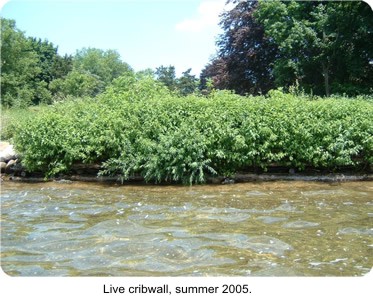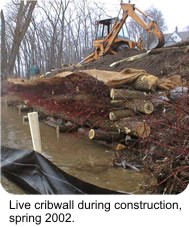Landscape Two
 The following are the major features of Kellogg Biological Station (KBS) Shoreline Management Demonstration Area Lakescape Two.
The following are the major features of Kellogg Biological Station (KBS) Shoreline Management Demonstration Area Lakescape Two.
Live cribwall
A live cribwall is an interlocking arrangement of timbers alternated with layers of live woody shrub cuttings. These include Streamco willow, ruby red osier dogwood, silky dogwood, gray dogwood and common elderberry. This technique is useful for stabilizing steep slopes or when replacing a traditional sea wall. We used black locust timbers on a steep bank for their resistance to rot. The timbers interlock in log cabin fashion and alternate with layers of topsoil, snuggly wrapped in coconut blankets, and live woody shrub cuttings (Figure 1) that have been harvested in the dormant stage.
The cribwall was installed in spring 2002 and is creating a six-foot deep rootmass as it grows into the bank. By the time the black locust timbers have rotted away, these roots will have stabilized 36 feet of steep bank against erosion. It is providing shade and habitat for fish, birds, turtles and other shoreline animals, and demonstrates a vegetated alternative to vertical sea wall.
 Habitat enhancement
Habitat enhancement
The woody shrubs incorporated into the live cribwall provide shade for fish and turtles and food and nesting areas for shoreline birds. The short grass prairie, dormant-seeded fall 2003, is comprised of native wildflowers and grasses that benefit birds and butterflies. Unfortunately, an old willow tree on Lakescape Two had to be taken down and removed in 2008 due to safety concerns.
Reduced lawn maintenance
The turf area in Lakescape Two is limited to a walkway and a picnic/viewing area, a strategy that significantly reduces the amount of intensive lawn management in this sensitive shoreline area.
Septic systems
In shoreline areas with poorly maintained septic systems and high water tables, sewage effluent released to groundwater can carry phosphorus and nitrogen to the lake where it can contribute to nuisance aquatic plant growth. Lakescape Two demonstrates the use of long-rooted short grass prairie plants that can help intercept septic system nutrients before they reach the lake.